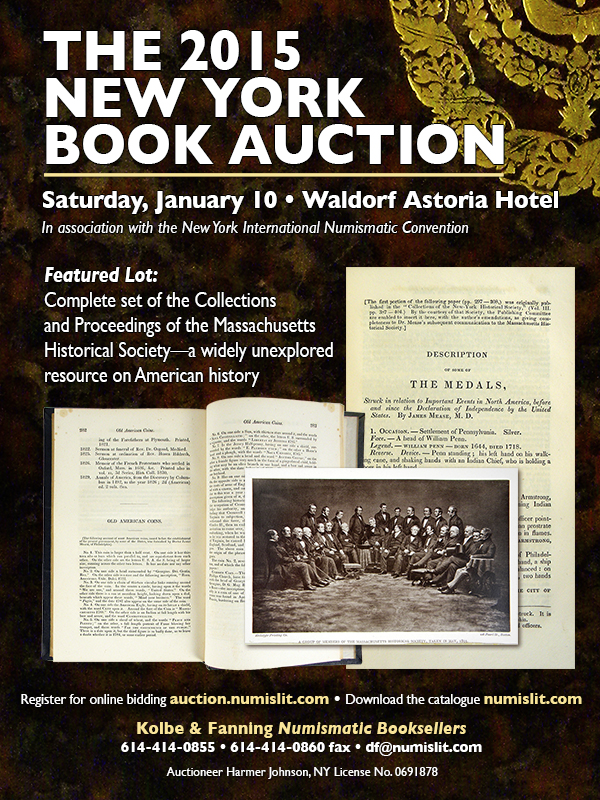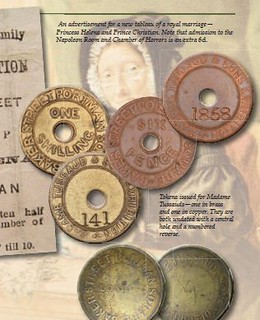
PREV ARTICLE
NEXT ARTICLE
FULL ISSUE
PREV FULL ISSUE
THE TOKENS OF MADAME TUSSAUD'S EXHIBITIONThe January 2015 issue of Coin News has a nice article by David Young on the tokens of Madame Tussaud's exhibition.
Here's an excerpt, with permission. Many thanks for publisher Philip Mussell. -Editor
1802 Marie decided to take her models to London and set up a display at the Lyceum in the Strand. The following year she took the exhibition to Edinburgh and two years later she was in Ireland. Marie and Joseph, her elder son, spent the next 30 years touring the country setting up the displays for a few days or several months depending on how many people paid to see the exhibitions. It was during these travels that Marie’s other son, Francis, came to join his brother and mother. The three of them returned to London in 1832 and three years later settled permanently at the Bazaar on the corner of Baker Street and Portman Square. Over the years there had been many waxwork displays in London so Marie had to make sure that hers had something special that would attract the visitors. She had learnt from Curtius that having models of some the personalities of the day was always popular, so along with the various tableaus of the royal family and George IV’s coronation there were models of politicians, actors and opera singers—and a corner was set aside for the latest villains. Marie had always been fascinated by Napoleon, having met him when he was First Consul and again on his way to St Helena. During the early 1840s many Napoleonic items were purchased including his travelling coach which had been at the Egyptian Hall. In 1843 two new rooms devoted to Napoleon were opened and were a great success, attracting many visitors. As the number of criminals on display increased, a separate room was set aside for them; it was the magazine, Punch, that coined the phrase “chamber of horrors” when they used it as a term of derision in describing one of the displays, but it had the opposite effect and drew even more visitors. Advertisements of the time show that the price of admission for adults was one shilling and sixpence for children and it seems likely that the metal tickets were issued around this time as their values correspond with the prices of admission. The two tokens are very similar in design, but the shilling is usually found in brass while the sixpence is normally in copper. They are both undated with a central hole and all are numbered on the reverse. The obverse has the value in the centre and around the edge reads BAKER STREET PORTMAN SQUARE, while in the centre of the reverse is the number and around the edge MADAME TUSSAUD & SONS EXHIBITION. There is a third brass token on which the legend around the edge of the obverse and reverse are the same as the previous ones, but in the centre of the obverse it reads LONDON while the centre of the reverse is blank. This piece was possibly used to gain admission to the Napoleon rooms as an extra sixpence was charged to see them, otherwise its purpose is unclear and, as usual, no references have been found to the use of these tokens. A portrait of Marie, showing her still working, was painted when she was 84. By this time she had taken her sons, Joseph and Francis, into partnership and when she died in 1850, they took over the business. It was they who in 1884 moved the exhibition to its present site in Marylebone Road in new purpose-built premises. A card ticket giving entrance to the exhibition is signed by John Tussaud, and may well have been given by him, it also allowed admittance to the extra rooms. Madame Tussaud’s had become part of the establishment and was one of the places to visit when in London; that was until 1925 when fire destroyed nearly all the building and its contents. Rebuilding started straight away and the exhibition re-opened in 1928 with the addition of a cinema. Unfortunately this was destroyed in the war and some years later the Planetarium was opened instead. The last of Marie’s descendants who took an active part in the management of the company was her great grandson Bernard, who died in 1967. For more information, or to subscribe to Coin News, see:
 Wayne Homren, Editor The Numismatic Bibliomania Society is a non-profit organization promoting numismatic literature. See our web site at coinbooks.org. To submit items for publication in The E-Sylum, write to the Editor at this address: whomren@gmail.com To subscribe go to: https://my.binhost.com/lists/listinfo/esylum All Rights Reserved. NBS Home Page Contact the NBS webmaster 
|
